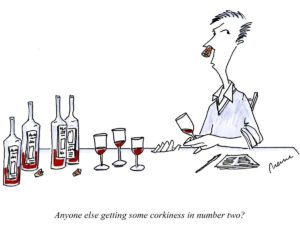
The most common actionable fault in wine, by far, is what’s known as cork taint: A condition that announces its presence with an off-putting whiff of wet basement, soggy cardboard, mold, or vague but insistent mustiness.
Less common (but not exactly rare) is a bottle that gives the impression that someone has poured out some of the wine and replaced it with water. The source of both faults is the same — the presence of trichloroanisole (TCA) in the winery. The infection settles into the cork closures and the contamination migrates from there.
Wine contaminated with TCA is thus commonly referred to as being corked (or corky), whichever of these two ways it presents itself. When we find a bottle in this condition in the wine corner, it’s a disappointment, of course, but also an opportunity. We like to send it around the store for everyone to sniff, so that they will know the problem when they encounter it at home, or in a wine bar or resto.
One of the mysteries of TCA taint is that it’s typically not the case that every bottle, or even a majority, of those leaving a given cellar will be afflicted; so just providing another bottle typically resolves the issue.
One of its more provoking aspects is the challenge of actually making the call to condemn. If you know the wine, then it’s very likely you will immediately detect that it’s out of sorts. If unknown, and if the signs of what you suspect may be taint are faint or uncertain, it can be a challenge to determine just what’s going on.
When your FKC wine team is tasting wines with vendors, we occasionally encounter something that raises a doubt along these lines. When we do, and the case isn’t perfectly obvious, a discussion inevitably ensues: Is it or isn’t it?
When our own experience leaves us in doubt, we appeal to the salesperson for a weigh-in. Since vendor reps are normally experienced with the wine they sell, this often settles the issue. When it doesn’t, we might ask for another bottle to be brought by for a second tasting.
This approach is one you can and should adopt when at a bar or in a restaurant dining room, by the way, since the server or the sommelier will presumably know the wine better than you do, and be in a position to offer an informed opinion. This is the primary reason they always give someone at the table a chance to sniff and sip before filling each guest’s stem. You’re expected to raise an objection if something doesn’t seem right, and not just nod your head reflexively.
We’ve learned that the scents and flavors of natural wine, can, when unfamiliar, set of TCA alarms. But naturalist wines, even at their most outlandish, do not reproduce the specifically disagreeable traits of a corked wine. While we don’t mud wrestle with customers over this point, we do encounter the ‘corked’ claim from time to time, when, in fact, the wine is merely not what the consumer expected or finds normative.
Think you’ve got a tainted wine on your hands? By all means speak up. And if it’s because a cork has surreptitiously embedded itself in a nostril, you can count on our being discreet.